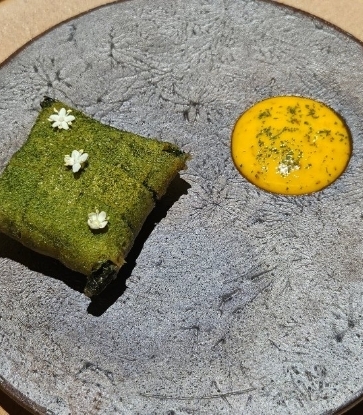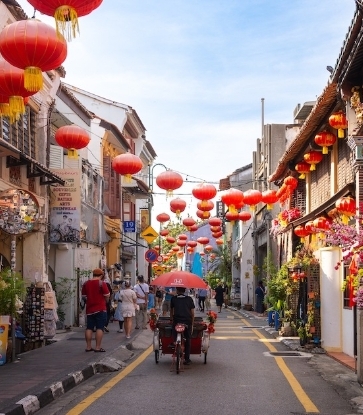Present in many forms, sambal, an indispensable chilli paste in Malaysian cuisine, is oftentimes enhanced with the addition of aromatic herbs and spices. No one has kept tabs on the actual number sambal varieties in this region — Indonesia alone boasts of more than two hundred. But one thing is indisputable; this chilli-based condiment takes centrestage in the Southeast Asian culinary world.
So how did chilli, a New World crop, become the key ingredient for what can be deemed as Malaysia’s national condiment? To understand, one needs to journey back five centuries through the pages of history.

The Arrival of Chillies: A Brief History
The Spice Trade, which transported exotic spices like cinnamon, cassia, and nutmeg from the fabled Spice Islands to Europe, had been in existence for more than a millennium when it was disrupted by the fall of Constantinople. Another cause was the Ottoman Empire’s subsequent ban on Christian traders from key trading stops along the route under their dominion.
Because of this, the Europeans had to look for an alternative route to the Spice Islands — modern-day Moluccas, the only place in the world where nutmeg was found back then.
Portuguese adventurer, Bartholomeu Diaz, rounded The Cape of Good Hope in 1488, heralding the discovery of a new sea route to India. By 1510, after a series of forays into India, the Portuguese under Afonso de Albuquerque, set up their first colony in Goa, India. From there, they expanded to Malacca, where they overthrew the last Malay sultanate in 1511. For centuries, Malacca had been a centre of commerce for the spice trade, where seaman from across the Malay Archipelago brought their products for barter.
Just a couple of decades earlier, Genoan-born Christopher Columbus, spearheading the Spanish effort to discover a new route, had founded the Americas in 1492. Potential new food sources, which included the chilli, corn, potato, tomato, and a whole host of other previously unknown crops were brought back to Europe. These New World food crops were to later find their way East as the Portuguese setup their maritime empire, stretching from Mozambique to Macau.
The world’s dietary patterns and culinary cultures were about to undergo a very drastic change.
The chilli first found its way to Portuguese Goa, and subsequently Malacca, where the local populace welcomed the crop with an enthusiasm far surpassing the earlier reception it got back in Portugal or in Europe.

Tools Used on the Chillies
With the chillies came the tools needed to grind them into a paste. The Mexican molcajete (mortar and pestle) became the batu lesong in Malacca, used to pound the chillies into a paste or purée, depending upon which dish was to be cooked.
Batu giling (similar to the metate in Mexico) was also common: a flat granite slab and an accompanying cylindrical rolling pin. Chillies are ground by sliding the rolling pin to and fro; crushing the chilis in between the rough surfaces of the slab and the rolling pin.

1. Sambal Belacan
Enjoyed with: Fried fish, Malay or Nyonya ulam (raw vegetables, salad), jiu hu char (Penang-Nyonya stewed jicama with cuttlefish), Nyonya lam mee
Both enjoyed as a condiment or as a dip, sambal belacan is indispensable to both Nyonya, as well as Malay, cooking. Traditionally, in a Nyonya home, the rhythmic pounding of chillies and its accompanying ingredients heightens one’s anticipation of a meal.
Sambal belacan constitutes of three basic ingredients: fresh red chillies, toasted belacan (fermented shrimp paste), and a squeeze of calamansi (lime).

Sambal Belacan as a Dip
Sambal belacan is an all-important condiment when having the Penang-Nyonya dish of Jiu Hu Char (braised jicama with cuttlefish), usually served in a lettuce leaf wrap. A dollop of spicy, pungent sambal belacan cuts through the richness of the braised dish, whilst adding another taste dimension to its savoury-sweet flavours.
Just as important is the sambal belacan as an accompaniment to Melakan-Nyonya Ayam Pongteh (Nyonya chicken and potato stew), as it provides an assertive stab of heat that elevates the stewed chicken to another level of deliciousness.

Sambal Belacan as a Dressing
Penang-Nyonya cuisine has a pantheon of spicy salads, called kerabu, of which there are many types, but all are inevitably pepped up by sambal belacan as its central flavouring agent.
Lashings of sambal belacan would be tossed with crisp jungle ferns (kerabu pucuk paku), blanched chicken feet (kerabu kay kar), or stewed pig’s ears (kerabu too hee), together with lime juice, and coconut milk in some instances. Nothing, it seemed, lay beyond the reach of the sambal belacan to be transformed into a product of sheer deliciousness. Like an old Nyonya chef in Penang once said, “Good sambal makes my kerabu sing.”
Where to enjoy Sambal Belacan in Kuala Lumpur: Anak Baba (Bib Gourmand, MICHELIN Guide Kuala Lumpur & Penang 2023), Limapulo (Selected, MICHELIN Guide Kuala Lumpur & Penang 2023)
Where to enjoy Sambal Belacan in Penang: Auntie Gaik Lean’s Old School Eatery (One MICHELIN Star, MICHELIN Guide Kuala Lumpur & Penang 2023), Bibik’s Kitchen (Selected, MICHELIN Guide Kuala Lumpur & Penang 2023), Kebaya Dining Room (Selected, MICHELIN Guide Kuala Lumpur & Penang 2023)

2. Sambal Tumis
Enjoyed with: Nasi lemak, grilled seafood, Nyonya laksa
Sambal tumis, as its name suggests (tumis means “to sauté” in Malay), involves slow-frying a blend of dried and fresh chillies that have been ground together with other accompanying aromatics such as shallots, garlic, galangal, lemongrass, fresh turmeric root, and toasted belacan in hot oil.
Sautéing the blended chilli paste over low heat smoothens the sharp edges of the raw ingredients, resulting in a mellower, gentler sambal tumis. Salt, palm sugar, and tamarind water are added towards the end, as one adjusts the flavours to his or her liking.

Sambal Tumis and Nasi Lemak
Nasi lemak, the unofficial Malaysian national dish, is often defined as a trinity of rice, coconut milk, and sambal, which means it would not have pre-dated the introduction of the chillies to Asia by the Portuguese in the early-1500s. Like the sambal, nasi lemak’s alluring popularity spanned the Malay archipelago: from Sumatera, down the Malay peninsula, and across the oceans to Java and Bali, all the way to the fabled Spice Islands.
In Malaysia, the love for nasi lemak transcends ethnic boundaries: the Malay, Chinese, and Indian communities each have their own variant, but in all renditions, the sambal will be ever-present. Simply put, the heat from the chillies, juxtaposed against the richness of coconut milk-infused rice, presents a pleasurable gustatory experience that would cut across all the different culinary cultures present.
Sambal Tumis for Cooking
Malaysian cooking unabashedly incorporates sambal tumis widely into its repertoire: slathered over deep-fried or grilled fish, or stirred into seafood or kangkong (water spinach) during cooking. Dishes accented by sambal tumis are often served alongside steamed rice and have an almost ubiquitous presence on the Malaysian dining table.
Where to enjoy Sambal Tumis in Kuala Lumpur: Dancing Fish (Bib Gourmand, MICHELIN Guide Kuala Lumpur & Penang 2023), Congkak (Bukit Bintang) (Bib Gourmand, MICHELIN Guide Kuala Lumpur & Penang 2023)
Where to enjoy Sambal Tumis in Penang: Rasa Rasa (Bib Gourmand, MICHELIN Guide Kuala Lumpur & Penang 2023), Ali Nasi Lemak Daun Pisang (Selected, MICHELIN Guide Kuala Lumpur & Penang 2023), Jawi House (Selected, MICHELIN Guide Kuala Lumpur & Penang 2023)

3. Hainanese Chicken Rice Chilli-Vinegar Dip
Enjoyed with: Poached chicken, chicken rice, soy-braised pork
Traditional Hainanese Chicken Rice in Malaysia and Singapore calls for the chilli-vinegar dip, which is essentially a liquid form of sambal.
The Hainanese, who hailed from Hainan Island off the southern coast of China, have been emigrating to Southeast Asia since the mid-19th century and became synonymous with culinary excellence, with their predominance in the food and service industry, especially the running of traditional coffeeshops or kopitiams.
One of the best-known and popular dishes in Malaysia is the Hainanese Chicken Rice, a dish derived from the Wenchang Chicken Rice back in their Hainan homeland. The dish essentially calls for poached chicken, served with a rich, aromatic rice that has been pre-fried with chicken fat, and then cooked in chicken stock with scallions, ginger, and pandan leaves.
One local innovation to the dish here that does not exist back on Hainan Island is the spicy chilli-vinegar dip.
The recipe for chilli-vinegar dip calls for a blend of fresh red chillies, ginger, garlic, vinegar, salt, and sugar, all ground together and then slow-boiled in a saucepan, with chicken stock and chicken drippings. The cooled concoction will be stored in jars and served at room temperature when needed.
An inseparable component of a Hainanese Chicken Rice meal, how good its chilli-vinegar dip is can be a make-or-break factor for a chicken rice establishment.
Where to enjoy Hainanese Chicken Rice Chilli-Vinegar Dip in Kuala Lumpur: Nam Heong Chicken Rice (Bib Gourmand, MICHELIN Guide Kuala Lumpur & Penang 2023), Wong Mei Kee (Bib Gourmand, MICHELIN Guide Kuala Lumpur & Penang 2023), Nasi Ayam Hainan Chee Meng (Jalan Kelang Lama) (Bib Gourmand, MICHELIN Guide Kuala Lumpur & Penang 2023)
Where to enjoy Hainanese Chicken Rice Chilli-Vinegar Dip in Penang: Fatty Loh Chicken Rice (Selected, MICHELIN Guide Kuala Lumpur & Penang 2023), Goh Thew Chik Hainan Chicken Rice (Selected, MICHELIN Guide Kuala Lumpur & Penang 2023)
All images are via Shutterstock




















